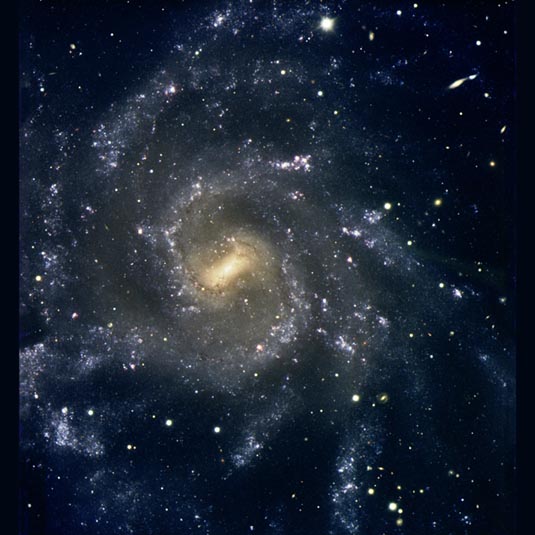
Barred Spiral Galaxy
RA 22h 57m 18.41s Dec -41° 4' 14.49"
Grus
37.5 million light years (11.5 Mpc)
9.5 x 8.1 arcmin
6.47 x 7.22 arc-minutes
11.0
North is 0.2° left of vertical
ESO
December 1, 2004
ABOUT THIS IMAGE:
This galaxy imaged by the VLT is a barred spiral, the beautiful multi-armed NGC 7424 that is seen almost directly face-on. Located at a distance of roughly 40 million light-years in the constellation Grus (the Crane), this galaxy was discovered by Sir John Herschel while observing at the Cape of Good Hope.
This example of a "grand design" galaxy is classified as "SAB(rs)cd", meaning that it is intermediate between normal spirals (SA) and strongly barred galaxies (SB) and that it has rather open arms with a small central region. It also shows many ionized regions as well as clusters of young and massive stars. Ten young massive star clusters can be identified whose size span the range from 1 to 200 light-years. The galaxy itself is roughly 100,000 light-years across, that is, quite similar in size to our own Milky Way galaxy.
Because of its low surface brightness, this galaxy also demands dark skies and a clear night to be observed in this impressive detail. When viewed in a small telescope, it appears as a large elliptical haze with no trace of the many beautiful filamentary arms with a multitude of branches revealed in this striking VLT image. Note also the very bright and prominent bar in the middle.
On the evening of December 10, 2001, Australian amateur astronomer Reverend Robert Evans, observing from his backyard in the Blue Mountains west of Sydney, discovered with his 30cm telescope his 39th supernova, Supernova 2001ig in the outskirts of NGC 7424. Of magnitude 14.5 (that is, 3000 times fainter than the faintest star that can be seen with the unaided eye), this supernova brightened quickly by a factor 8 to magnitude 12.3. A few months later, it had faded to an insignificant object below 17th magnitude. By comparison, the entire galaxy is of magnitude 11: at the time of its maximum, the supernova was thus only three times fainter than the whole galaxy. It must have been a splendid firework indeed!
By digging into the vast Science Archive of the ESO Very Large Telescope, it was possible to find an image of NGC 7424 taken on June 16, 2002 by Massimo Turatto (Observatorio di Padova-INAF, Italy) with the FORS 2 instrument on Yepun (UT4). Although, the supernova was already much fainter than at its maximum 6 months earlier, it is still very well visible on this image (see ESO Press Photo eso0436d).
Spectra
taken with ESO's 3.6-m telescope at La Silla over the months following
the explosion showed the object to evolve to a Type Ib/c supernova. By
October 2002, the transition to a Type Ib/c supernova was complete. It
is now believed that this supernova arose from the explosion of a very
massive star, a so-called Wolf-Rayet star, which together with a massive
hot companion belonged to a very close binary system in which the two
stars orbited each other once every 100 days or so. Future detailed observations
may reveal the presence of the companion star that survived this explosion
but which is now doomed to explode as another supernova in due time.